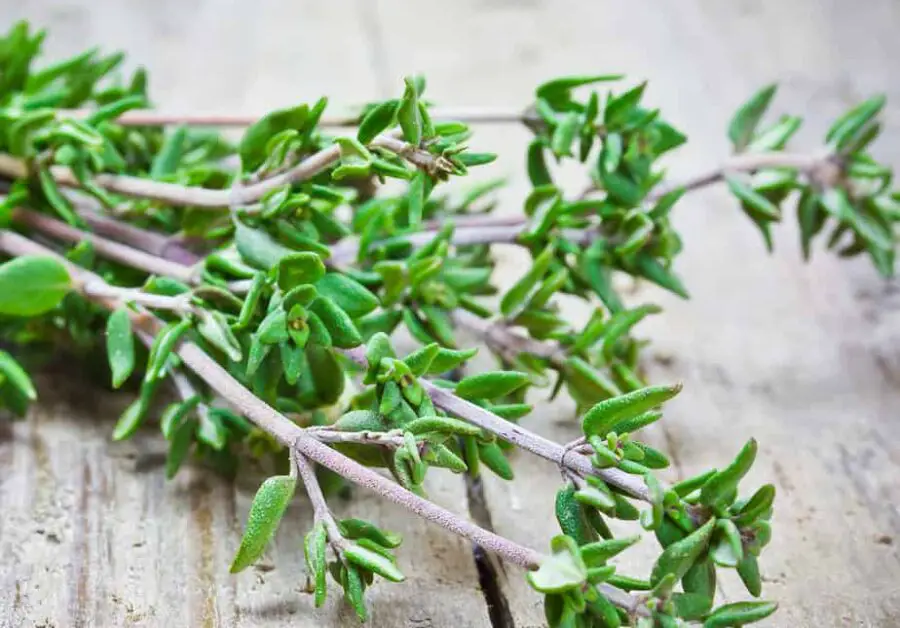I don’t know about you but the aroma of thyme wafting through the kitchen is a one-of-a-kind scent. It makes you feel warm inside and hungry all at the same time!
No matter if you’re planning a delicate fish dish or a hearty stew, thyme is one of those special ingredients that can take flavor to the next level.
However, the very same thing that makes thyme such a potent ingredient is also what makes it so noticeable when a little more of it than needed finds its way into your recipe.
Of course, we’ve all been there – what starts out as a pinch or two quickly becomes overload and before you know it, your dish has too much thyme in it. But that’s no reason to panic and throw out your dish. We’ve got some tips and tricks that can help you salvage even the most thyme-heavy mistakes and turn them into not only something edible but something delicious!
Beyond that, we’ll dive deep into thyme itself – exploring everything from its flavor profile to how you can use it reliably and never worry about over-seasoning again. So get ready and make sure you have enough time on your hands (pun intended) because whether you’re a veteran cook or a wanna be chef, we’ve got just the information you need to get the most out of using this delectable spice in your kitchen.
Fixing a Dish with Too Much Thyme – 5 Easy Ideas to Try
Even though it might seem hopeless, we promise that there are few creative ideas you can try. Think carefully about your situation and the go for the option that makes the most sense.
Balance Out the Bitterness
One of the fastest (and easiest) things you can do is to add something acidic or sweet to your recipe. For a dish that’s too thyme-heavy, a simple pinch of sugar or a light drizzle of honey might do the trick.
When considering acidic options, a splash of lemon juice if often enough to brighten the recipe and tamp down the bitter notes of excess thyme.
Try Some (or More) Starch
If appropriate for your recipe, a great option for fixing a dish that has too much thyme, is to add starchy ingredients. Starches are great at absorbing strong flavors like thyme and can help to disperse them more evenly throughout the dish.
The great thing about starches is that there are lots of options to choose from. Some popular choices include:
- Adding potatoes to a stew or soup.
- Stirring in some pasta into a saucy dish.
- Mixing in rice or quinoa to a dish like a casserole or a pilaf.
- Using breadcrumbs to thicken a sauce or a filling, and give it a nutty flavor.
Dilution Might be A Solution
As with adding sweet or acidic options earlier, another simple approach can be adding liquid to your dish to help dilute it. This is particularly true if you are already making something like soup or stew that has a large amount of liquid already present.
For slightly thicker liquids like sauces, you can dilute them with ingredients like cream or butter.
Remove the Thyme
If you’ve tried one (or more) of the options already listed but are still finding the flavor of thyme too strong for your liking, you can remove some (or all) of the thyme from your recipe.
This is especially true in cases where you’re using fresh thyme as opposed to dried. This is because the leaves of fresh thyme are going to impart a much stronger flavor.
Make a Larger Batch
Lastly, if your dish is still too strong and you don’t want to throw it away, consider making a larger batch and then dividing it in half. Use one half with the thyme as is, and then add extra ingredients on the other half to balance it out. This way you’ll still have a usable dish, and you’ll learn something new for next time.
The chances are good that one of the ideas we’ve mentioned will probably help you resolve your dilemma but if not, a last option to consider is simply making a larger batch of your dish.
The easiest way to do this is to keep the portion with the thyme as it is and add additional ingredients but leaving out the thyme to balance things out.
While this can seem like a lot of extra effort, you’re pretty much guaranteed to tone down the thyme-forward flavor and you’ll have gained some invaluable information about your recipe should you want to make it again in the future.
And speaking of the future…
| Method | Description |
|---|---|
| Balance Out the Bitterness | “Include a touch of acidity or sweetness to your recipe by using a small amount of sugar or lemon juice to enhance the flavor and balance out the harsh notes of excess thyme. |
| Try Some (or More) Starch | Add starchy ingredients such as potatoes, pasta, rice, quinoa or breadcrumbs to absorb strong flavors and disperse them evenly throughout the dish. |
| Dilution Might be A Solution | Add liquid to your dish to dilute it. Thick liquids like sauces can be thinned out with ingredients like cream or butter. |
| Remove the Thyme | Remove some or all of the thyme from your recipe, particularly if you are using fresh thyme. |
| Make a Larger Batch | Make a larger batch of your dish, keeping the portion with the thyme as it is and add additional ingredients but leaving out the thyme to balance things out. |
Future Proof Your Recipes – Understanding Thyme and How to Use It
Now that you’ve got few ideas for fixing your current thyme crisis, it’s a good idea to understand its strong, woody flavor so that you don’t make the same mistake in the future.
If I could give you one tip to keep in mind when it comes to thyme it’s this – balance is the key.
Taste as You Go
The tricky part is arriving at that perfect balance of thyme’s unique flavor without it completely overwhelming your taste buds. To reach that balance I mentioned, the best practice is to slowly add thyme to your dish.
Small Amounts Go a Long Way
Start with a pinch or two and slowly build from there. It goes without saying that you should be taste testing as you go.
Pair with Complementary Flavors
You should also keep other flavors in the dish in mind. This is especially true with flavors that traditionally pair well with thyme like lemon, garlic and rosemary. If you’re not careful, thyme can quickly overpower them.
If you take this approach going from now on, the chances of you overdoing it are greatly reduced.
With that said, let’s get in to some tips and tricks you can use if the flavor of thyme in the recipe you’re making now has gotten away from you.
| Method | Description |
|---|---|
| Taste as You Go | Slowly add thyme to your dish and taste test as you go to reach a perfect balance of thyme’s unique flavor without it overwhelming your taste buds. |
| Small Amounts Go a Long Way | Begin with a small amount, such as a pinch or two and gradually increase as needed. |
| Pair with Complementary Flavors | Consider other flavors in the dish, particularly those that traditionally complement thyme well, such as lemon, garlic, and rosemary. |

Hiya! I’m Kimberly, a contributing writer here at Miss Buttercup. I was born and raised in the UP, Michigan’s Upper Peninsula for those who don’t know, the land of beautiful, beach-filled sunny summer days and bone-chilling long winters. Growing up there made me appreciate all the little things about life, especially the way a delicious meal can bring people closer together. I try and put that same feeling into each article I write and I hope it comes across that way!

